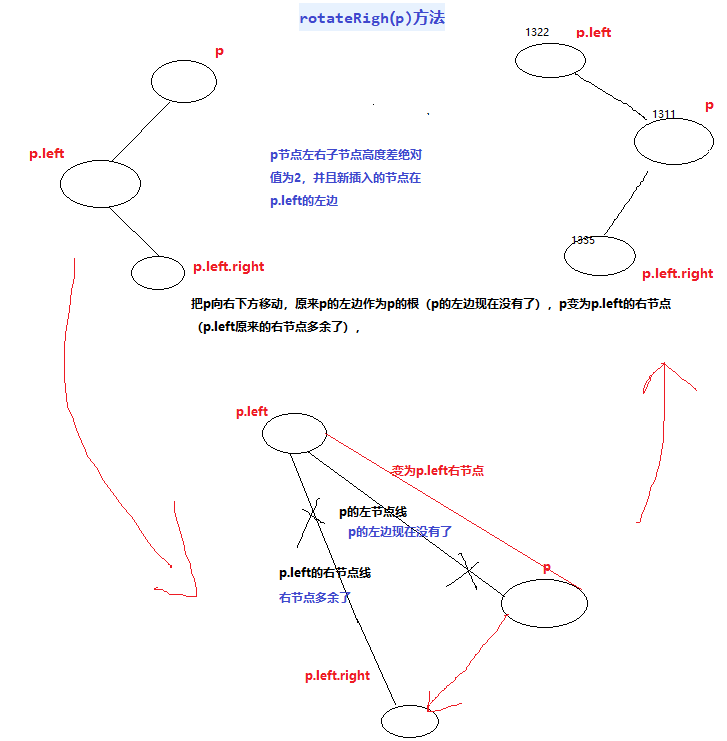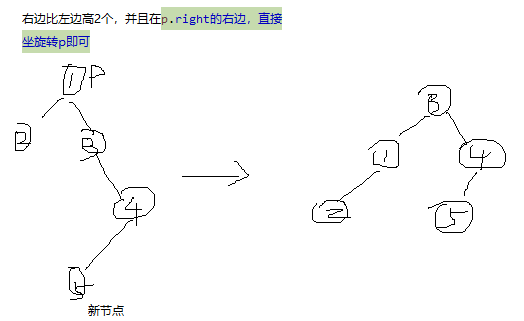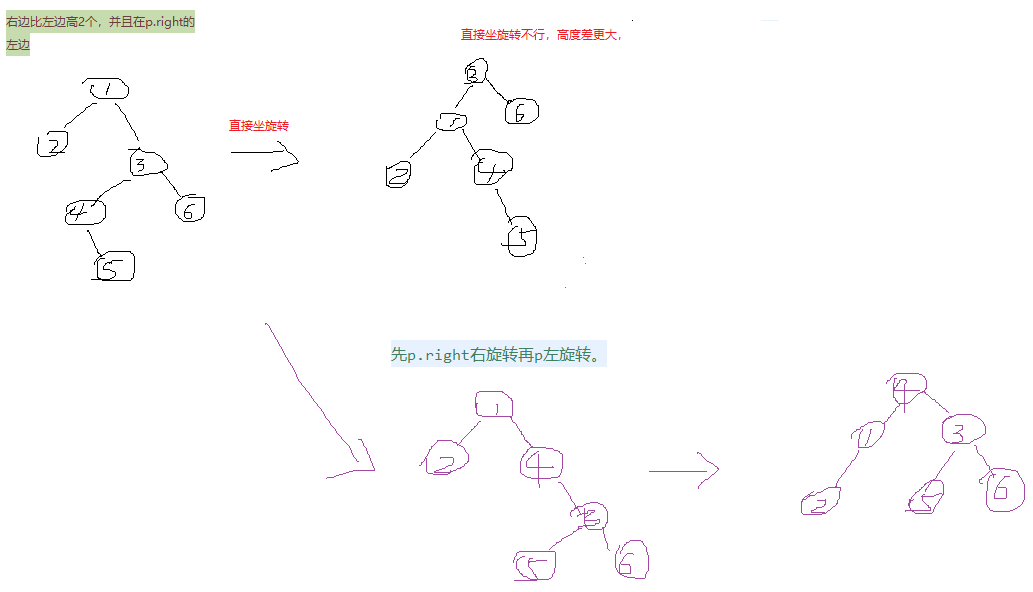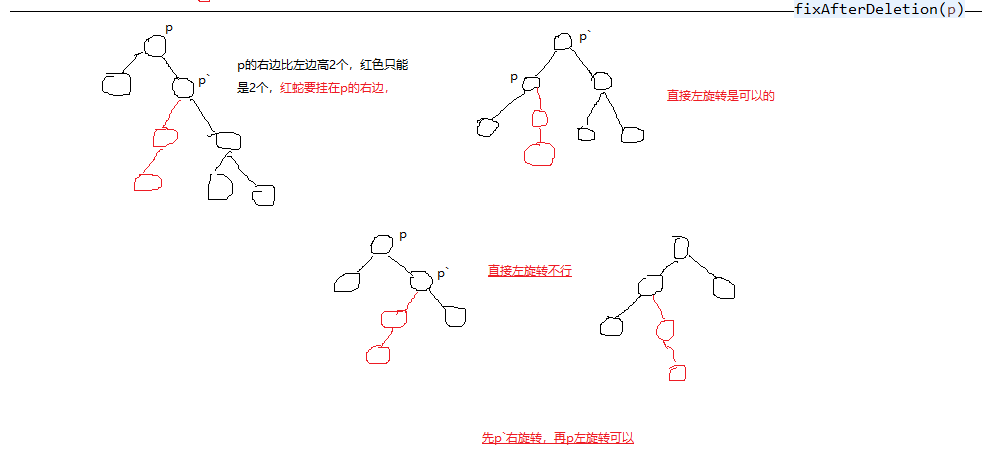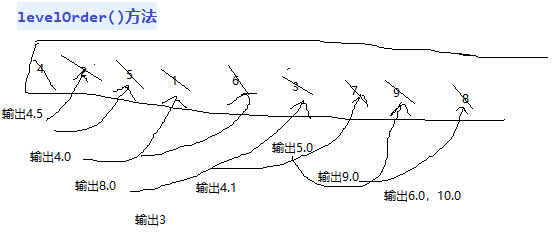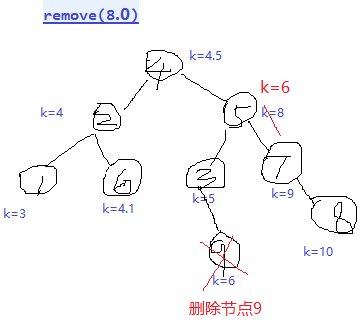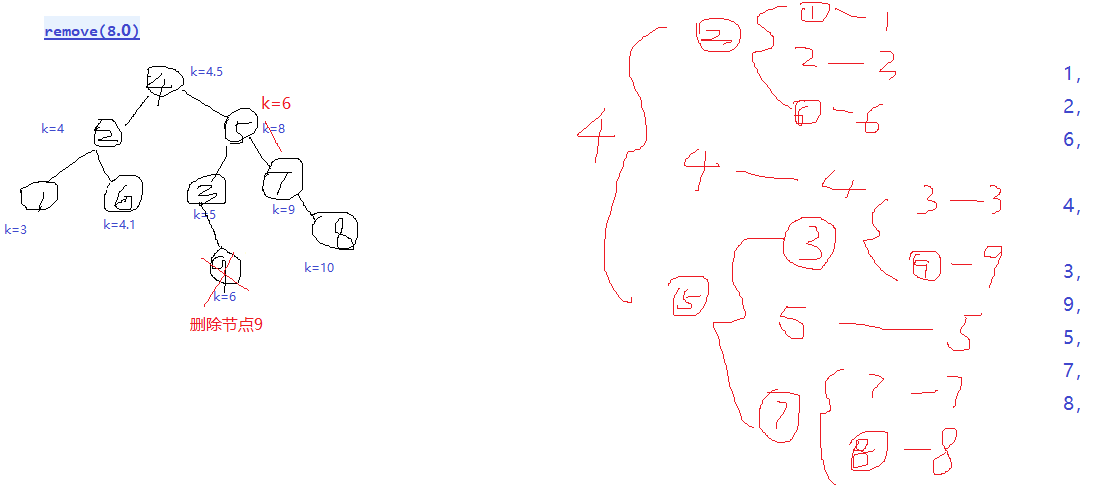public class AVLMap<K, V> implements Iterable<AVLEntry<K, V>> { private int size; private AVLEntry<K, V> root; private Comparator<K> comp; private LinkedList<AVLEntry<K, V>> stack = new LinkedList<AVLEntry<K, V>>(); private int compare(K a, K b) { if (comp != null) { return comp.compare(a, b);//有比较器就用比较器比较 } else { Comparable<K> c = (Comparable<K>) a; return c.compareTo(b);//没有比较器就用对象本身比较 } } public AVLMap(Comparator<K> comp) { super(); this.comp = comp; } public AVLMap() { super(); } public int size() { return size; } public boolean isEmpty() { return size == 0 ? true : false; } public V put(K key, V value) {//存放节点,并把相比较过了的节点加入到stack。 if (root == null) {//第一个元素是根 root = new AVLEntry<K, V>(key, value); stack.push(root); size++; } else { AVLEntry<K, V> p = root;//每次从根节点开始比较,stack存放依次比较路上的所有节点, while (p != null) { stack.push(p); //调整二叉树时候用 int compareResult = compare(key, p.key);//-1:<,key<p.key if (compareResult == 0) { p.setValue(value);//相等就覆盖 break; } else if (compareResult < 0) {//小于0就跟左节点比较,左节点入栈, if (p.left == null) { p.left = new AVLEntry<K, V>(key, value); System.out.println(p.left); size++; stack.push(p.left);//刚刚加入的节点也入栈 break; } else {// 还有左子树 p = p.left; } } else { if (p.right == null) {//大于0就跟右节点比较,右节点入栈, p.right = new AVLEntry<K, V>(key, value); size++; stack.push(p.right);//刚刚加入的节点也入栈 break; } else {// 还有右子树 p = p.right; } } } } fixAfterInsertion(key);//修改依次比较路上的所有节点的高度, return value; } @Override public Iterator<AVLEntry<K, V>> iterator() { return new AVLIterator<K, V>(root); } private AVLEntry<K, V> getEntry(K key) { AVLEntry<K, V> p = root; while (p != null) { int compareResult = compare(key, p.key); if (compareResult == 0) { return p; } else if (compareResult < 0) { p = p.left; } else { p = p.right; } } return null; } public boolean containsKey(K key) { AVLEntry<K, V> p = getEntry(key); return p != null; } public V get(K key) { AVLEntry<K, V> p = getEntry(key); return p != null ? p.getValue() : null; } public boolean containsValue(V value) { Iterator<AVLEntry<K, V>> itr = this.iterator(); while (itr.hasNext()) { if (itr.next().getValue().equals(value)) { return true; } } return false; } public AVLEntry<K, V> getFirstEntry(AVLEntry<K, V> p) { if (p == null) { return null; } while (p.left != null) { p = p.left; } return p; } public AVLEntry<K, V> getLastEntry(AVLEntry<K, V> p) { if (p == null) { return null; } while (p.right != null) { p = p.right; } return p; } private AVLEntry<K, V> deleteEntry(AVLEntry<K, V> p, K key) {//从根节点开始删除, if (p == null) { return null; } else { int compareResult = compare(key, p.key); if (compareResult == 0) {//删除就是p节点,不是删除p节点,而是修改p节点,删除的是被替换的节点。 if (p.left == null && p.right == null) { p = null; } else if (p.left != null && p.right == null) { p = p.left; } else if (p.left == null && p.right != null) { p = p.right; } else {//从右边和从左边开始是一样的。 if ((size & 1) == 0) {//偶数 AVLEntry<K, V> rightMin = getFirstEntry(p.right);//p.right最左边的节点,就是比p大但是最小的。 p.key = rightMin.key; p.value = rightMin.value;//修改要删除节点p的k,v, AVLEntry<K, V> newRight = deleteEntry(p.right, p.key);//从p.right开始删除p.key p.right = newRight;//修改要删除节点p的right, } else {//奇数 AVLEntry<K, V> leftMax = getLastEntry(p.left);//p.left最右的节点,就是小于p但是最大的, p.key = leftMax.key; p.value = leftMax.value; AVLEntry<K, V> newLeft = deleteEntry(p.left, p.key);//从p.left开始删除p.key p.left = newLeft; } } } else if (compareResult < 0) { AVLEntry<K, V> newLeft = deleteEntry(p.left, key);//从p.left开始删除,返回并修改新的顶点p.left p.left = newLeft; } else { AVLEntry<K, V> newRight = deleteEntry(p.right, key);//从p.right开始删除,返回并修改新的顶点p.right p.right = newRight; } p = fixAfterDeletion(p); return p;//返回的是根节点 } } public int getHeight(AVLEntry<K, V> p) { return p == null ? 0 : p.height;//p==null?0:Max(getHeight(p.left),getHeight(p.right))+1 } private AVLEntry<K, V> rotateRight(AVLEntry<K, V> p) {//向右旋转,返回现在的顶节点p.left AVLEntry<K, V> left = p.left; p.left = left.right; left.right = p; p.height = Math.max(getHeight(p.left), getHeight(p.right)) + 1;//重新计算高度 left.height = Math.max(getHeight(left.left), p.height) + 1;//重新计算高度 return left; } private AVLEntry<K, V> rotateLeft(AVLEntry<K, V> p) {//向左旋转,返回现在的顶节点p.right AVLEntry<K, V> right = p.right; p.right = right.left; right.left = p; p.height = Math.max(getHeight(p.left), getHeight(p.right)) + 1;//重新计算高度 right.height = Math.max(p.height, getHeight(right.right)) + 1;//重新计算高度 return right; } private AVLEntry<K, V> firstLeftThenRight(AVLEntry<K, V> p) { p.left = rotateLeft(p.left);//p.left.right为p.left p = rotateRight(p); return p; } private AVLEntry<K, V> firstRightThenLeft(AVLEntry<K, V> p) { p.right = rotateRight(p.right); p = rotateLeft(p); return p; } //一路上比较的节点都要重新调整大小,因为新加进去的节点在这些节点的下面,所以这些节点都要重新调整高度。 private void fixAfterInsertion(K key) {//从新插入的节点到根节点,依次修改比较路上的节点的高度, AVLEntry<K, V> p = root;//根 while (!stack.isEmpty()) { p = stack.pop();//比较路上的所有节点,包括刚刚加进去的节点,第一次pop出来的是最外面的节点, //就是刚刚加进去的节点,高度是1,然后依次修改比较路上的节点的高度。不在比较路上的节点的高度不要修改。 int newHeight = Math.max(getHeight(p.left), getHeight(p.right)) + 1; if (p.height > 1 && newHeight == p.height) {//节点p的高度没改变 stack.clear();//那么p的上层节点高度也没改变 return; } p.height = newHeight;//修改高度 int d = getHeight(p.left) - getHeight(p.right); if (Math.abs(d) <= 1) {//绝对值 continue; } else {//左右子树高度差>=2,每次只增加一个节点,所以高度差从2开始,不会大于2,等于2就开始旋转调整。 if (d == 2) {//p左边比右边高2个, //新插入的节点在p.left的左边,直接p右旋转, if (compare(key, p.left.key) < 0) { p = rotateRight(p);//返回现在的顶节点 } else {//新插入的节点在p.left的右边,先把p.left左旋转, p = firstLeftThenRight(p); } } else {//-2,p右边比左边高2个, if (compare(key, p.right.key) > 0) {//p.right的右边直接左旋转即可。 p = rotateLeft(p);//返回现在的顶节点 } else {//先p.right右旋转再p左旋转。 p = firstRightThenLeft(p); } } if (!stack.isEmpty()) {//peek()不移除元素 if (compare(key, stack.peek().key) < 0) {//表示在节点stack.peek()的左边 stack.peek().left = p;//就设置左边 } else { stack.peek().right = p; } } } } root = p;//修改根节点 } public void checkBalance() {//断言AVL树的平衡性 postOrderCheckBalance(root); } private void postOrderCheckBalance(AVLEntry<K, V> p) { if (p != null) { postOrderCheckBalance(p.left); postOrderCheckBalance(p.right); Assert.assertTrue(Math.abs(getHeight(p.left) - getHeight(p.right)) <= 1); } } public V remove(K key) { AVLEntry<K, V> entry = getEntry(key); if (entry == null) { return null; } V oldValue = entry.getValue(); root = deleteEntry(root, key);//从根节点开始删除。删除路上的所有节点都要重新调整为平衡二叉树。 size--; return oldValue; } public void levelOrder() { Queue<AVLEntry<K, V>> queue = new LinkedList<AVLEntry<K, V>>(); queue.offer(root); int preCount = 1; int pCount = 0; while (!queue.isEmpty()) { preCount--; AVLEntry<K, V> p = queue.poll(); System.out.print(p + " "); if (p.left != null) { queue.offer(p.left); pCount++; } if (p.right != null) { queue.offer(p.right); pCount++; } if (preCount == 0) { preCount = pCount; pCount = 0; System.out.println(); } } } public AVLEntry<K, V> fixAfterDeletion(AVLEntry<K, V> p) { if (p == null) { return null; } else { p.height = Math.max(getHeight(p.left), getHeight(p.right)) + 1; int d = getHeight(p.left) - getHeight(p.right); if (d == 2) {//左节点比右节点高2个,不可能超过2个,一次只加进去一个节点,影响高度是1,是2的时候就已经调整了。 if (getHeight(p.left.left) - getHeight(p.left.right) >= 0) { p = rotateRight(p);//左边>=右边高可以直接右旋转p。 } else { p = firstLeftThenRight(p);//右边比左边高,就要先把p.left左旋转,然后在右旋转p。 } } else if (d == -2) {//右节点比左节点高2个 if (getHeight(p.right.right) - getHeight(p.right.left) >= 0) { p = rotateLeft(p); } else { p = firstRightThenLeft(p); } } return p; } } @SuppressWarnings({ "rawtypes", "unchecked", "unused" }) public static void main(String[] args) { AVLMap al = new AVLMap(); al.put(5d, 55d); al.put(4d, 44d); al.put(3d, 33d); al.put(4.5d, 4.55d); al.put(8d, 88d); al.put(4.1d, 4.11d); al.put(9d, 99d); al.put(10d, 100d); al.put(6.0d, 6.0d); Iterator i = al.iterator();//[{k:4.5,L:{k:4.0,L:{k:3.0},R:{k:4.1}},R:{k:8.0L:{k:5.0},R:{k:9.0,R:{k:10.0}}}},{k:4.0,L:{k:3.0},R:{k:4.1}},{k:3.0}] while(i.hasNext()) { System.out.println(i.next().toString()); } AVLEntry j = al.getEntry(4.5d); al.levelOrder(); double o = (Double) al.remove(8d); AVLMap<Person, Integer> map = new AVLMap<Person, Integer>(new Comparator<Person>() { public int compare(Person o1, Person o2) { return o2.id - o1.id; } }); for (int i1 = 0; i1 < 16; i1++) { map.put(new Person(new Random().nextInt(16), "name" + new Random().nextInt(16)), new Random().nextInt(16)); } Iterator<AVLEntry<Person, Integer>> itr = map.iterator(); while (itr.hasNext()) { System.out.println(itr.next().getKey()); } } }
public class AVLEntry<K, V> implements Map.Entry<K, V> { public K key; public V value; public AVLEntry<K, V> left; public AVLEntry<K, V> right; public int height = 1;//单个结点高度就是1 } }
public class AVLIterator<K, V> implements Iterator<AVLEntry<K, V>> {//遍歷器 private Stack<AVLEntry<K, V>> stack; public AVLIterator(AVLEntry<K, V> root) { super(); stack = new Stack<AVLEntry<K, V>>(); addLeftPath(root);//從根開始,最左边都加进去。 } private void addLeftPath(AVLEntry<K, V> p) { while (p != null) { //p入栈时候,把他的所有子左节点都加里面。右节点不在里面,出来的时候把右节点加进去(这样右节点就在里面了), 加这个右节点时候同时把所有子左节点加进去。 //从根开始,所谓的左节点都是入栈时候加进去的,所谓的右节点都是出栈时候加进去的(加这个右节点时候也叫入栈,把所有子左节点加进去)。 stack.push(p); p = p.left; } } @Override public boolean hasNext() { return stack.isEmpty() ? false : true; } @Override public AVLEntry<K, V> next() { AVLEntry<K, V> p = stack.pop();//pop()是要移除元素的。 addLeftPath(p.right);//pop()出去时候把右节点加进去,加右节点时候把该节点的所有左节点加进去。 return p; } @Override public void remove() { throw new ConcurrentModificationException("Can not remove!"); } }
